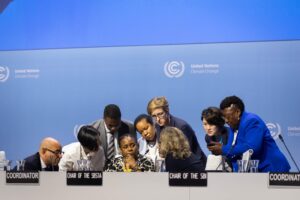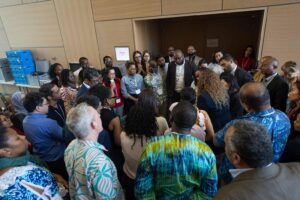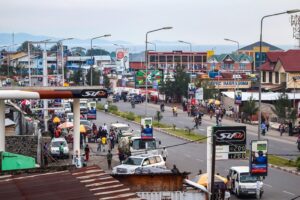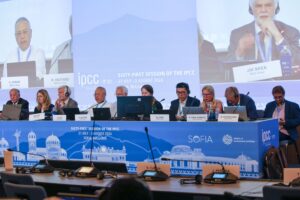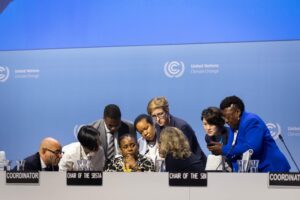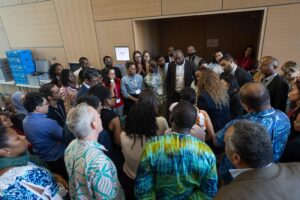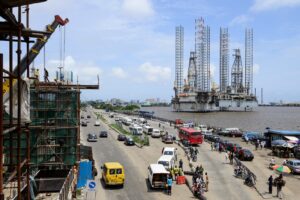The centrepiece of every UN climate summit is for countries to negotiate the wording of a large number of legal agreements – and COP30 in the Brazilian city of Belém is no different.
These texts are hashed out behind closed doors in the “blue zone” at the COP, where diplomats from nearly 200 nations haggle over every paragraph and each individual verb.
Over the course of the two-week summit, negotiators will be trying to reach consensus on more than 100 separate agreements – but, first, they must agree which issues are on the agenda.
The complexity of this process can make it challenging to keep track of what countries are fighting about and how negotiations are progressing.
Carbon Brief’s real-time text tracker, below, offers a helping hand by decoding the agenda and keeping a searchable record of every document for each part of the negotiations.
The first column of the interactive tracker lists the topic of each agenda item, with further columns including dates, page counts and links to the original PDFs.
The table is searchable via the interactive text box and can be sorted using the arrow icons.
Key negotiations at COP30 include those on the “global goal on adaptation”, as well as the question of whether or how to reform the COP process itself, a discussion that appears on the agenda under the innocuous heading: “Arrangements for intergovernmental meetings.”
While most of the items on the agenda are agreed in advance, parties can suggest late additions. These must be signed off before negotiations can begin, often resulting in an “agenda fight”.
Recent negotiations have all started with an agenda fight over two proposals from the Like-Minded Developing Countries (LMDCs) – a group that includes China, India and Saudi Arabia.
The LMDC proposals relate to the provision of climate finance by developed countries – under Article 9.1 of the Paris Agreement – and to what they describe as “unilateral trade measures”, a term understood to include the EU’s carbon border adjustment mechanism (CBAM).
The LMDCs have asked again that these issues be included on the agenda at COP30.
Ahead of the opening of the summit, Carbon Brief’s text tracker counts 111 substantive items on the agenda, not including procedural matters, such as the election of COP officials.
However, it is likely that not all of these items will ultimately end up being included.
The figure below illustrates the status of the COP30 negotiations overall, in a traffic-light format. Each agenda item is colour-coded according to its current status.
For topics shown in red, negotiators have not yet managed to put anything down on paper, perhaps because parties have fundamentally different views on how they should proceed.
For items in orange, negotiators are working on an “informal text”, which is an early draft setting out the views of different parties, but not yet expressed in formal legal language.
Once a draft legal agreement becomes available, topics will be colour-coded yellow. At this point, areas of remaining disagreement will be denoted in the text with [square brackets] and “options”.
As such, texts with many square brackets or options tend to be an indicator of a high level of disagreement between parties within this negotiation track. For this reason, the tracker table above counts and displays the number of outstanding brackets and options in each document.
During the course of the summit, negotiators may work through multiple iterations of text on each agenda item. These documents may include “bridging text”, designed to resolve differences of opinion and to find a “landing zone” that all groups can agree on.
Agreement is reached on a given topic once all brackets and options have been resolved, at which point the issue will be coloured green in Carbon Brief’s traffic-light chart.
Where agreement cannot be reached, discussions may be subject to “rule 16”, meaning negotiations are postponed until the next session. These topics are colour-coded grey.
The figure below gives an at-a-glance overview of the status of the main topics up for negotiation.
As parties narrow down the options and brackets towards the end of each summit, they start to generate “clean” texts, which contain no areas of disagreement and can be converted into “draft decisions” that are ready for formal adoption at the closing plenary of the meeting.
Finally, at the closing plenary, each draft decision must be gavelled through by the COP president, signifying its formal adoption as a legal agreement and outcome of the summit.
This last step is usually a formality, but dramatic exceptions are possible.
During the closing plenary at COP29, the president of the meeting failed to adopt a deal relating to the “global stocktake” from 2023, which had called for “transitioning away” from fossil fuels.
Carbon Brief also ran text trackers for COP28 and COP29.
The post Interactive: Tracking negotiating texts at the COP30 climate summit appeared first on Carbon Brief.
Interactive: Tracking negotiating texts at the COP30 climate summit
Greenhouse Gases
DeBriefed 7 November 2025: Belém COP begins; UN warns of 1.5C breach; changing roles of climate scientists
Welcome to Carbon Brief’s DeBriefed.
An essential guide to the week’s key developments relating to climate change.
This week
Eve of COP30
MULTILATERAL HOPES A gathering of world leaders kicked off in Belém, Brazil, ahead of the official opening of COP30 next week. The leaders of China, the US and India – the “planet’s three biggest polluters” – are “notably absent” from the two-day leaders summit, reported the Associated Press. Some Latin American leaders “were openly critical” of the US president’s stance on climate change in their speeches at the “diminished” summit, noted the Financial Times.
‘MORAL FAILURE’: Speaking at the world leaders summit, UN secretary-general António Guterres described failing to remain below 1.5C as a “moral failure and deadly negligence”, reported the Guardian. Guterres added: “Every fraction of a degree means more hunger, displacement and loss – especially for those least responsible.” The UN chief’s speech came as the World Meteorological Organization confirmed that 2025 is “on track to be the second or third warmest globally”, noted Reuters.
‘POSITIVE TIPPING POINT’: The Brazilian COP presidency published a “Baku to Belém roadmap” detailing how climate finance for developing nations could be scaled up to $1.3tn a year by 2035, Climate Home News reported. The roadmap was published ahead of the UN climate talks, but will not be formally discussed as part of the negotiations, the outlet added. Read Carbon Brief’s summary of what the roadmap means for climate finance.
FORESTS NOT FOREVER: Brazil also launched its Tropical Forests Forever Facility (TFFF) this week, said Agence France-Presse, designed to help tropical countries protect their forests. Norway has joined France and Brazil in investing in the fund, while Germany will announce its contribution on Friday, noted Bloomberg. The Guardian dubbed the UK’s decision to opt out as “a major letdown”. For more on the TFFF, see Carbon Brief’s explainer.
UN report says world is heading for 2.8C
UNFULFILLING: The United Nations Environment Programme (UNEP) annual “emissions gap” report warned that global temperature rise could be heading for 2.8C this century, if only current policies are fulfilled, the Financial Times reported. The rise could be limited to 2.5C, if unconditional national pledges are met in full – or to 2.3C, if pledges conditional on financial support are put into action, the newspaper noted.
STALLED PROGRESS: The world’s warming trajectory is now “0.3C lower than it was a year ago…meaning new plans announced this year have done little to move the needle”, noted Reuters. Some of this progress will be “cancelled” out, the New York Times added, once the US withdrawal from the Paris Agreement takes effect. See Carbon Brief’s in-depth coverage of the UNEP report.
Around the world
- WATERED DOWN: The EU finally confirmed a “significantly weakened” plan to cut emissions to 90% below 1990 levels by 2040, reported the Financial Times.
- DEADLY DISASTER: The Philippines is in a state of emergency after Typhoon Kalmaegi left at least 114 people dead and nearly 130 missing.
- DROPPING COMMITMENTS: The junior partner in Australia’s opposition Coalition – the Nationals – has formally abandoned a commitment to reach net-zero emissions by 2050, reported ABC News.
- MAYORAL WIN: Zohran Mamdani won New York City’s mayoral election, having “refram[ed] climate policy as a quality-of-life issue”, Inside Climate News reported.
100
The number of proposed indicators to track progress towards the “global goal on adaptation” that will be negotiated at COP, according to Carbon Brief‘s new Q&A.
Latest climate research
- Rising temperatures could affect the muscles that Arctic bumblebees use to generate their “charismatic buzz” | Nature Communications
- The release of CO2 from the the Southern Ocean has been “underestimated” by up to 40% in previous studies | Science
- Outdoor heat stress has led to a 10% decline in labour capacity in “rural to urban migration hotspots” in India | Environmental Research Letters
(For more, see Carbon Brief’s in-depth daily summaries of the top climate news stories on Monday, Tuesday, Wednesday, Thursday and Friday.)
Captured
IPCC funding shortfall

Carbon Brief covered the latest meeting of the Intergovernmental Panel on Climate Change (IPCC) in Lima, Peru. Alongside funding from parent organisations the World Meteorological Organization (WMO) and UN Environment Programme, voluntary contributions by countries help pay for the work of the IPCC. The biggest contributors so far in 2025 are Norway, the UNFCCC, Canada and the WMO. The red bars show how US contributions have dropped off during Trump’s two terms in office. Having provided 30% of direct contributions throughout the IPCC’s history, the US has not made a contribution so far this year.
Spotlight
‘With knowledge comes responsibility’: the changing role of climate scientists in a warming world
This week, Carbon Brief speaks to a researcher about the different ways climate scientists are feeling and taking responsibility for the knowledge they hold.

From calling for action in Belém to defending science against attempts to discredit or downplay it, climate scientists are responding to world events in ever-more visible ways.
Dr Friederike Hartz is a research and policy associate at University College London.
For her PhD thesis, carried out at the University of Cambridge, Hartz interviewed 77 experts who participated in IPCC reports, the world’s most authoritative global assessments of climate science coordinated by the UN.
‘You can’t unsee it’
Hartz’s findings show how climate scientists can feel a sense of responsibility, as those who bear the knowledge and evidence of climate change.
Some interviewees felt a sense of “representational responsibility” – motivated by the wish to improve the lives of the vulnerable or underrepresented communities they belong to.
Others expressed a sense of “intergenerational responsibility”, resolving to contribute to a better world for their children and grandchildren.
Hartz called this the “inescapability” of climate knowledge. She told Carbon Brief:
“Once you know, you know. As one of my interviewees shared with me, you simply can’t unsee it. Especially as a scientist, you’re trained to see those things.”
Taking responsibility
Hartz’s research looked at what it means for climate scientists to act on the sense of responsibility they feel, beyond producing the science itself.
Some take part in formal IPCC assessments. Others “have come to accept and further embrace a responsibility for communicating” their knowledge, Hartz noted in her paper.
Beyond the IPCC, some scientists take on additional responsibility for evidence-based “advocacy” or even call for more “activism” in science.
Similarly, on the grounds that “with knowledge comes responsibility”, some have called for scientists to “step beyond their traditional roles” or act as “sentinels” to alert society to threats. Hartz told Carbon Brief:
“This is all part of what I call ‘science enactment’: putting science into action or putting it in the hands of other people who can act on it.”
Navigating what it means to take responsibility is a very individual thing, said Hartz, which speaks to late biologist Stephen Schneider’s “double ethical bind” – the balance between a commitment to the “scientific method” and the “wish to see the world a better place”.
Lived experience
Hartz pointed to research suggesting the traditional view – that engaging in activism or advocacy can damage a scientist’s credibility – may be unwarranted. But there can be other downsides, she noted, including the emotional toll. As one of her interviewees expressed it:
“As scientists, we are not droids…And, so, to say that we are not at all influenced by what is going on in science is not true.”
Hartz suggested that scientists can simultaneously experience feelings of enthusiasm about their work and frustration about its uptake. Or as she noted in her thesis, citing a seminal political science study:
“Knowledge can only speak ‘truth to power’ to the extent that ‘power listens to truth’.”
Watch, read, listen
‘WHITE HOUSE EFFECT’: A Netflix documentary looked at how a “crucial opportunity” to take climate action was “deliberately undermined” during the George HW Bush administration.
‘COP OF TRUTH’: Brazil’s president, Luiz Inácio Lula da Silva, wrote in the Guardian ahead of COP30 about the need to act “with the urgency the climate crisis demands”.
HUMAN STORIES: A video by the Grantham Institute at Imperial College London explored the pivotal moments leading to the historic establishment of a loss and damage fund.
Coming up
- 10 November: UN Climate Change conference (COP30) begins in Belém, Brazil
- 12 November: IEA World Energy Outlook 2025 launch, Paris
- 13 November: Global Carbon Budget annual update released
Pick of the jobs
- Project Drawdown, program manager, research fellow and senior analyst | Salary: Various. Location: Remote
- UK Centre for Ecology and Hydrology, laboratory assistant | £26,206 – £27,808. Location: Lancaster, UK
- Ofwat, Wales environmental policy lead | £57,783 – £72,000. Location: Cardiff, UK
- UNEP, mitigation expert on sand and dust storms | Salary: Not specified. Location: Riyadh, Saudi Arabia
- Conservation International, senior manager, climate & landscape restoration | Salary: Not specified. Location: Acornhoek, South Africa.
DeBriefed is edited by Daisy Dunne. Please send any tips or feedback to debriefed@carbonbrief.org.
This is an online version of Carbon Brief’s weekly DeBriefed email newsletter. Subscribe for free here.
The post DeBriefed 7 November 2025: Belém COP begins; UN warns of 1.5C breach; changing roles of climate scientists appeared first on Carbon Brief.
Greenhouse Gases
Ongoing failure to agree AR7 timeline is ‘unprecedented’ in IPCC history
Governments have, once again, failed to agree on a timeline for the Intergovernmental Panel on Climate Change (IPCC) seventh assessment cycle (AR7), two years into the process.
Last week, more than 300 scientists and government officials from around the world met in Lima, Peru for the 63rd session of the IPCC (IPCC-63).
According to the Earth Negotiations Bulletin (ENB), reporting exclusively from inside the four-day meeting, the closed-door talks were characterised by “fraught deliberations” where “once-routine” issues became “deeply controversial and time-consuming”.
Countries reached a compromise on the content of a methodology report on carbon dioxide removal technologies – a sticking point at the last IPCC meeting.
However, the meeting marked the fourth time in a row that delegates could not reach consensus on the timings of the IPCC’s influential three-part assessment report, after deadlocked talks in Hangzhou, China earlier this year and Sofia, Bulgaria and Istanbul, Turkey in 2024.
Observers told Carbon Brief of an atmosphere of “deepening mistrust” at the meeting, as emerging economies clashed with a coalition of small-island states and developed nations amid repeated accusations of “micromanagement”.
IPCC chair Prof Jim Skea reportedly lamented in his closing remarks that “as a category five hurricane [Hurricane Melissa] swept through the Carribean, IPCC-63 was deliberating on pronouns and footnotes”.
One former IPCC author tells Carbon Brief that certain countries’ opposition to agreeing a “deadline for AR7” was a “clear tactic for playing down the importance of IPCC climate science in decision-making on climate change”.
Historic splits
Each assessment cycle, the IPCC publishes three “working group” reports that focus on climate science (WG1), impacts and adaptation (WG2) and mitigation (WG3). It also publishes a small number of special reports and methodology reports.
The IPCC’s current assessment cycle has been underway since July 2023, with the authors for its three headline reports confirmed earlier this year.
It is atypical for the IPCC to have not yet agreed when these reports would be published so far into an assessment cycle. The workplans for AR5 and AR6 were “agreed with little difficulty”, the ENB notes in its summary of the event, adding:
“The debate about the timeline is unprecedented in the history of the IPCC.”
There are, broadly speaking, two camps in the debate around timelines for AR7.
The first wants a timeline that would align the publication of the IPCC’s three headline reports, plus special and methodology reports, with the second “global stocktake” (GST).
The GST is an appraisal of global progress on tackling climate change, which takes place every five years under the Paris Agreement. The second GST is scheduled to conclude at COP33 at the end of 2028, so that its findings can inform the fourth round of national climate pledges due a few years later.
Other countries, however, have advocated for a longer timeline. Among their concerns are the potential burden reviewing reports back-to-back could place on more resource-strapped countries, as well as whether the current schedule offers enough time for gaps in scientific literature to be filled.
As proceedings kicked off in Peru, the IPCC proposed a timeline for AR7 which would see all three of its headline reports published in 2028, with approval sessions earmarked for May, June and July of that year for the three working group reports.
WGI co-chair Dr Robert Vautard noted that the ongoing uncertainty on timelines was stressful for both the authors of reports, as well as for scientists wishing to submit research for the cycle, according to the ENB.
The delegation from Antigua and Barbuda, meanwhile, noted that agreement on the timeline is typically procedural and “not negotiated by governments”. It also said the proposed cycle length of around six-and-a-half years was consistent with the IPCC’s last two assessment cycles.

‘Compromise’ timeline
Throughout the four-day meeting, positions on both sides on the debate around AR7 remained “entrenched”, the ENB notes.
A “majority” of countries were in favour of a workplan which would align AR7 with the GST, the ENB says. However, this group was opposed by a “smaller, but growing” number of countries in favour of a less compressed timeline.
Early on in proceedings, for example, Kenya described a slower timeline as a “great equaliser” and said a more compressed timeline did not favour authors, nor the coordinating agencies, from developing countries, ENB says.
Meanwhile, India argued that the GST was “extraneous” to the IPCC and said there were no formal IPCC rules about aligning with the stocktaking exercise, according to ENB. Algeria, China, Libya, India, Russia, Saudi Arabia and South Africa also reportedly voiced their opposition to the IPCC’s proposals.
Inclusivity concerns were also cited by countries in favour of the IPCC’s timeline. For example, the small-island state of Vanuatu reportedly said that delaying the reports would deprive countries of important scientific information ahead of key international meetings.
Antigua and Barbuda, Australia, the Bahamas, France, the Gambia, Korea and Nepal were among the countries to speak up in favour of the IPCC’s proposed timeline, according to ENB.
Simon Steill, executive director of the UN Framework Convention on Climate Change (UNFCCC), urged countries to agree on a timeline which aligned AR7 with the GST. In his opening address to the Lima meeting, he said:
“Taken together, the reports will be indispensable and I will continue to urge all countries to agree on timelines that ensure all three assessments inform the second global stocktake.
“Because the stocktake is not just a technical exercise. It is a crucial moment for the world to recognise the state of play, reaffirm its commitment to Paris and respond with action and support at the pace and scale that science demands.”
The ENB reports that a contact group was set up on Monday to work through the issue, co-chaired by Brazil and Denmark.
On Tuesday, a revised timeline for AR7 was presented by WG1 co-chair Dr Xiaoye Zhang and WG2 co-chair Dr Bart Van den Hurk, which took into account deliberations from the contact group, the ENB says. It set out a number of changes to the initial timeline, concentrated at the end of the cycle so as to address government concerns while limiting impacts on report authors.
This included spacing out approval sessions – where the final reports are signed off line by line – so that WG2 would be held in July 2028 (instead of June) and WG3 in September (instead of July). It also set out an extension of expert and government review periods for report drafts.
Discussion of the revised schedule was deferred until Wednesday at the request of Ghana, Kenya, India, Russia and Saudi Arabia.
As talks resumed, a number of emerging-economy countries spoke out against the updated timeline, including Algeria, Jordan, Morocco, Tunisia and Zimbabwe, ENB notes.
Russia said that aligning the work of the IPCC with the UNFCCC would send a “negative signal”, ENB says, whereas China suggested that the timeline would put “pressure” on developing countries. South Africa similarly argued that the timeline would “harm” the inclusivity and geographic representativeness of the reports, according to ENB.
Among the countries in favour of the revised timeline were small-island developing states Haiti, Jamaica, Sao Tome and Principe and Vanuatu, as well developed economies Australia, Finland, Italy, Ireland, New Zealand and the UK, ENB says.
Grenada is quoted by ENB as describing the new timeline constituted a “compromise of a compromise”. The country also emphasised that it was supported by a majority of countries across regions and development levels, ENB says.
At the request of certain members of the contact group, WG1’s Vautard presented a visualisation of the new timeline for all three reports and the special report on cities on Wednesday evening. The graphic – seen by Carbon Brief – plots the timeline for “first-order” draft review (by experts), “second-order” draft review (by governments and experts), final government review and panel approval for each report.
Vautard noted that first-order draft reviews of the WG1 and WG2 reports overlapped “intentionally”, to allow experts to see both drafts at once.
(The request for a visualisation prompted accusations – not for the first time at the meeting – that certain countries were drawing the IPCC process into “micromanagement”, the ENB notes.)
The visualisation was followed by a new wave of objections from countries, who argued against a timeline where review periods for different reports overlapped with each other and UNFCCC meetings, according to ENB.
Among them were Russia and China, who argued that AR7 should be extended to 2029, ENB says. (Russia reportedly said it would “consider a plan” to deliver the overarching synthesis report by December 2029 – if its concerns were addressed.)
On the other hand, Antigua and Barbuda argued that avoiding any overlaps would not be feasible and expressed concerns that certain countries’ interventions seemed to be aimed “more at delay than progress”, the ENB notes.
Skea said he “struggled to see” why consecutive and overlapping reviews were a problem, according to the ENB. He noted that the IPCC rulebook states that panel and working group sessions should be scheduled to coordinate with, “to the extent possible, with other related international meetings”.
Lindsey Fielder-Cook, interim deputy director and the representative for climate change at the Quaker UN Office, was an observer to the talks. She tells Carbon Brief that “blocking” governments had “serious and genuine concerns” around the lack of equity inclusion in climate modelling and a failure of co-chairs to “sufficiently engage” with their proposals.
However, she says these countries also cited “structural” concerns around timing and capacity that “could be overcome” and speculated that these were “used to cover [for] what the countries do not say publicly”. She adds:
“For example, concerns include capacity and vacation times during [report] review times – which were not a concern raised by small-island developing states and many least-developed countries with even less capacity, [as well as concerns about] developing country scientific input, which the IPCC has made genuine efforts to improve.”
On Thursday evening, the facilitators of the contact group reported that no consensus had been reached, the ENB notes. Consequently, the IPCC agreed to – once again – defer decisions on the rest of the workplan to a future session.
Countries agreed that working groups should press on with activities and author meetings detailed in the 2026 budget.
(This outcome – where the IPCC plans in annual increments – had been described earlier in the week by Skea as the “worst option”. Nepal, meanwhile, said this result would “harm the IPCC’s legitimacy”.)
Routine issues ‘have become controversial’
This is now the fourth meeting in a row – following Istanbul, Sofia and Hangzhou – where the timeline for producing, reviewing and publishing the IPCC’s reports in AR7 has not been agreed.
In its analysis of the “fraught negotiations” in Lima, the ENB notes that “deep divisions” on the timeline and other procedural issues have “plagued the IPCC during the first two years of its seventh assessment cycle”. It added:
“Issues that were once routine have become deeply controversial and time-consuming.”
The failure to approve the timeline for AR7 was not the only issue on which countries were unable to agree. Approval of the official summaries of the two preceding IPCC meetings was also deferred, after certain countries said they could not sign off on the drafts.
After the previous IPCC meeting in Hangzhou, Skea told Carbon Brief that negotiations over just the outlines of the three AR7 working group reports “had some of the quality of an approval session”, where a finished report is scrutinised line by line.
In Lima, Skea “remarked that these disagreements [over the timeline] are unprecedented so early in an assessment cycle”, the ENB reports.
Throughout the meeting, the ENB records multiple instances of countries voicing their concerns about the implications for the work of the IPCC.
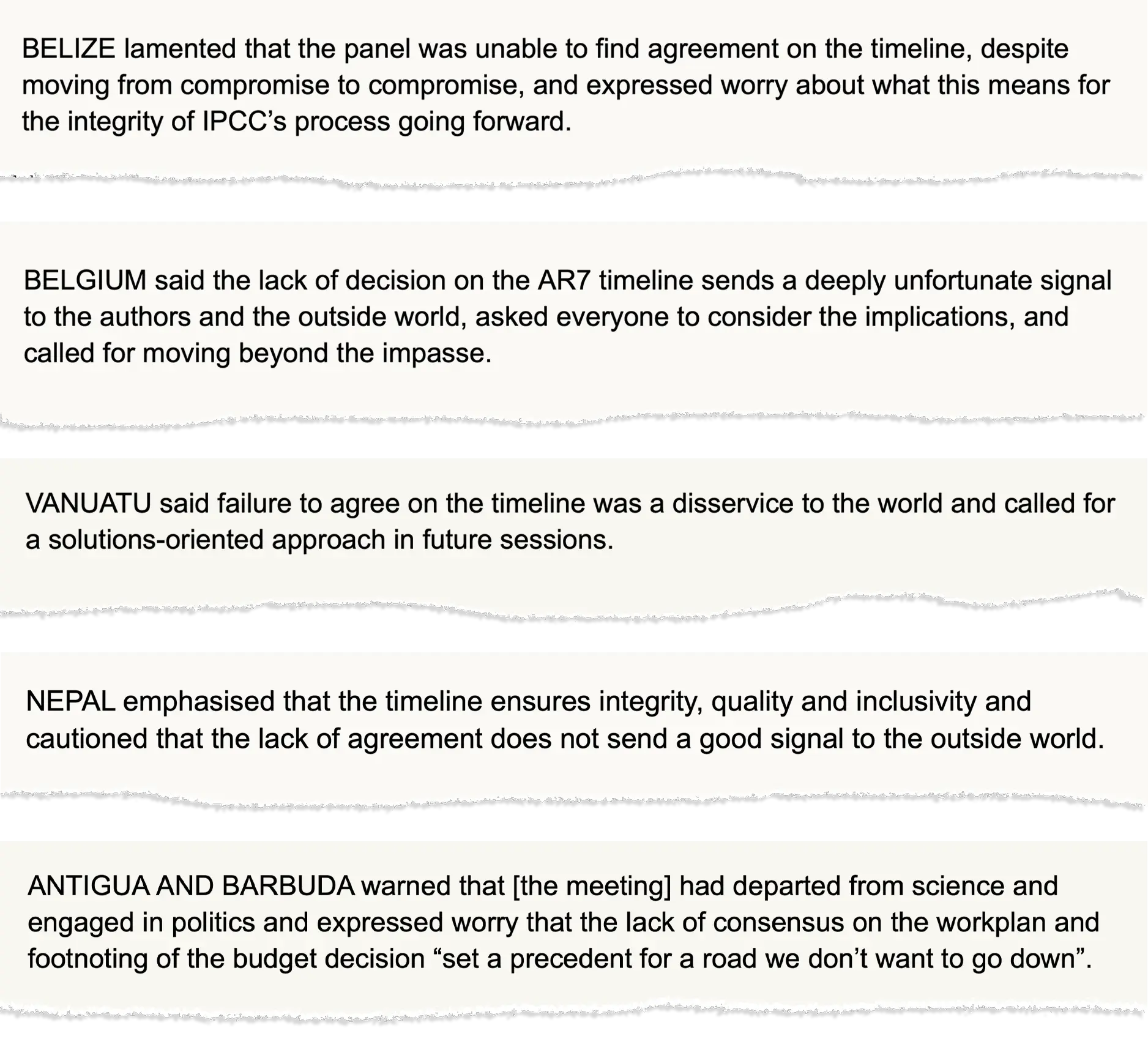
In its analysis of the meeting, the ENB says these concerns reflect “growing tensions within the panel, as “delegates expressed increasing frustration with what they see as inflexible positions”.
The ENB also notes:
“References made in this session to disrespectful interactions among delegates are atypical in the IPCC context and raise concerns that trust the basis for compromise and flexibility may be dwindling in some parts of the IPCC.”
(The IPCC has not responded to Carbon Brief’s multiple interview requests.)
In her observations, Fielder-Cook tells Carbon Brief that the meeting was “actually more relaxed” than recent IPCC sessions. This was “in part due to the gentle and generous hosting of Peru and in part to a sense of resignation on the timeline”.
Nonetheless, she says, the mood in the room was of “concern for the IPCC and its reputation, for its ability to protect science from intensifying political influence”, as well as “concern over the increasing political efforts to influence the scientific output”. She adds:
“While the work will continue, IPCC authors working voluntarily have no clear timeline on their voluntary commitment.”
Prof Lisa Schipper, a professor of development geography at the University of Bonn and IPCC AR6 author, tells Carbon Brief:
“Some countries refusing to set a deadline for the AR7 is a clear tactic for playing down the importance of IPCC climate science in decision-making on climate change. And this will be a problem if the report is done and cannot be approved and used by governments.”
Nonetheless, she adds, “there is plenty of good science being produced and governments are not in any way restricted from using this science in their decision-making”.
Ultimately, though, “we do need a decision on the AR7 timeline”, she says:
“No other single report provides the same evaluation and assessment of this collected knowledge or is able to give an authoritative overview of what we know, what we don’t know, and which future is more likely under different conditions.”
Consensus on CDR
Earlier this year in Hangzhou, governments failed to reach consensus on the outline for a methodology report on carbon dioxide removal (CDR) and carbon capture, utilisation and storage (CCUS) technologies, which is slated for publication in 2027.
This was largely due to disagreements around chapter seven in the proposed outline, a section that would focus on carbon removals from oceans, lakes and rivers.
On the first day in Lima, Takeshi Enoki – a co-chair of the IPCC task force on national greenhouse gas inventories (TFI), which is responsible for producing the report – introduced the outline and workplan for the methodology report.
Enoki explained that discussions about the report would focus on the table of contents and “particularly the proposed volume seven on the direct removal of CO2 from waterbodies”, according to ENB.
Fielder-Cook – the observer from the Quaker UN Office – tells Carbon Brief there was “significant concern” across a “range of developed and developing countries” over language in the initial methodology report outline that “could allow harmful marine geoengineering”.
Antigua and Barbuda, France and Germany were among the countries who opposed the inclusion of a seventh chapter. They cited concerns related to the “effectiveness, scalability, legality and environmental impacts” of marine CDR, the ENB notes.
Some of these countries suggested that the IPCC adopt the outline for “volumes one to six”, “with the possibility of adding to these volumes later”, the ENB says.
However, Saudi Arabia said that all “expert-recognised CDR and CCUS technologies, including marine-based technologies, must be considered”. It called for an outline that “encompasses the full spectrum of these technologies”.
ENB notes that the “point of contention” was whether the IPCC should develop methodologies for measuring and assessing the impacts of all CDR technologies. Some countries argued that the report should be limited to technologies that are “environmentally safe”, while others argued that it is “not the responsibility of a TFI methodology report to make that judgment”.

Skea set up a contact group on the first day of the meeting, facilitated by China and Turkey, to work on the outline of the report.
The following days saw “significant discussion” within the contact group, before delegates reconvened in plenary on Thursday to continue discussing the report, according to the ENB.
Delegates were eventually able to reach a compromise on the outline by agreeing to remove the chapter on direct removal of CO2 from waterbodies from the plan, the ENB reports.
Meanwhile, delegates agreed to hold an expert meeting on alkalinity enhancement – the addition of alkaline substances to seawater, which allows the ocean to take in more carbon from the atmosphere – and direct ocean capture. This meeting will be co-organised by the TFI and the three IPCC working groups.
Funding ‘shortfall’
At the Lima meeting, countries approved the IPCC’s budgets for 2025 and 2026, but also noted “with concern the significantly reduced cash balance” of the IPCC trust fund and the “accelerating decline” in the level of annual voluntary contributions from countries and other organisations, says the ENB.
The IPCC is funded by its parent organisations, the World Meteorological Organization (WMO) and UN Environment Programme (UNEP), along with voluntary contributions from member governments and the UNFCCC.
These contributions feed into the IPCC “trust fund”, which is used to pay for the work of the IPCC. In addition, member countries provide “in-kind” support, such as offering facilities for meetings and hosting the “technical support units” for each working group.
By the end of June, contributions in 2025 amounted to 1.2m Swiss francs (£1.1m) – significantly down compared to the annual totals of previous years. Compared to spending of 2.9m Swiss francs (£2.8m), this leaves a shortfall of around 1.7m Swiss francs (£1.6m) for 2025.
At the start of this year, the balance of the trust fund stood at 17.8m Swiss francs (£16.9m).
The chart below shows the direct contributions from countries and organisations throughout the IPCC’s history and up to the end of June this year.
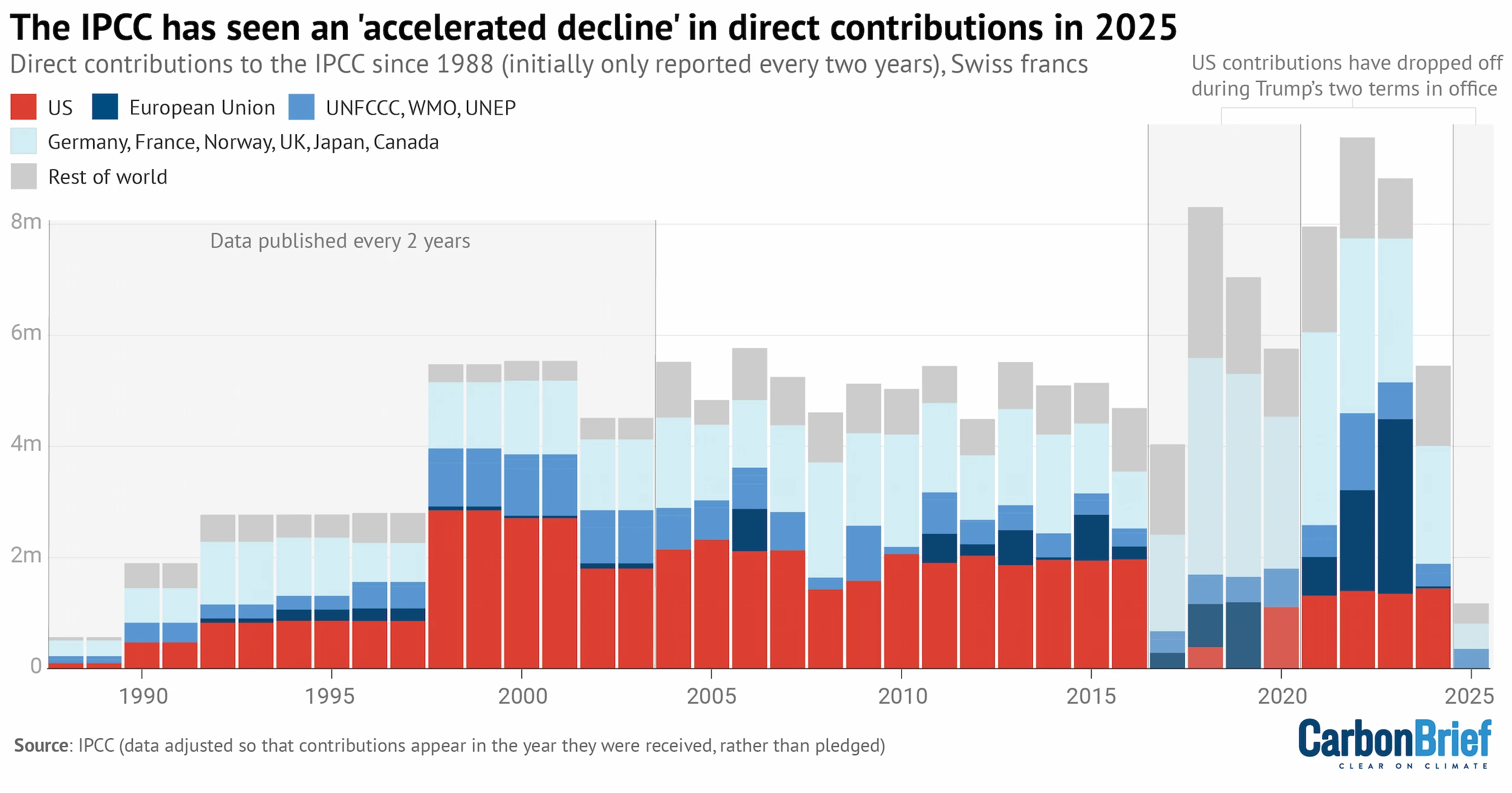
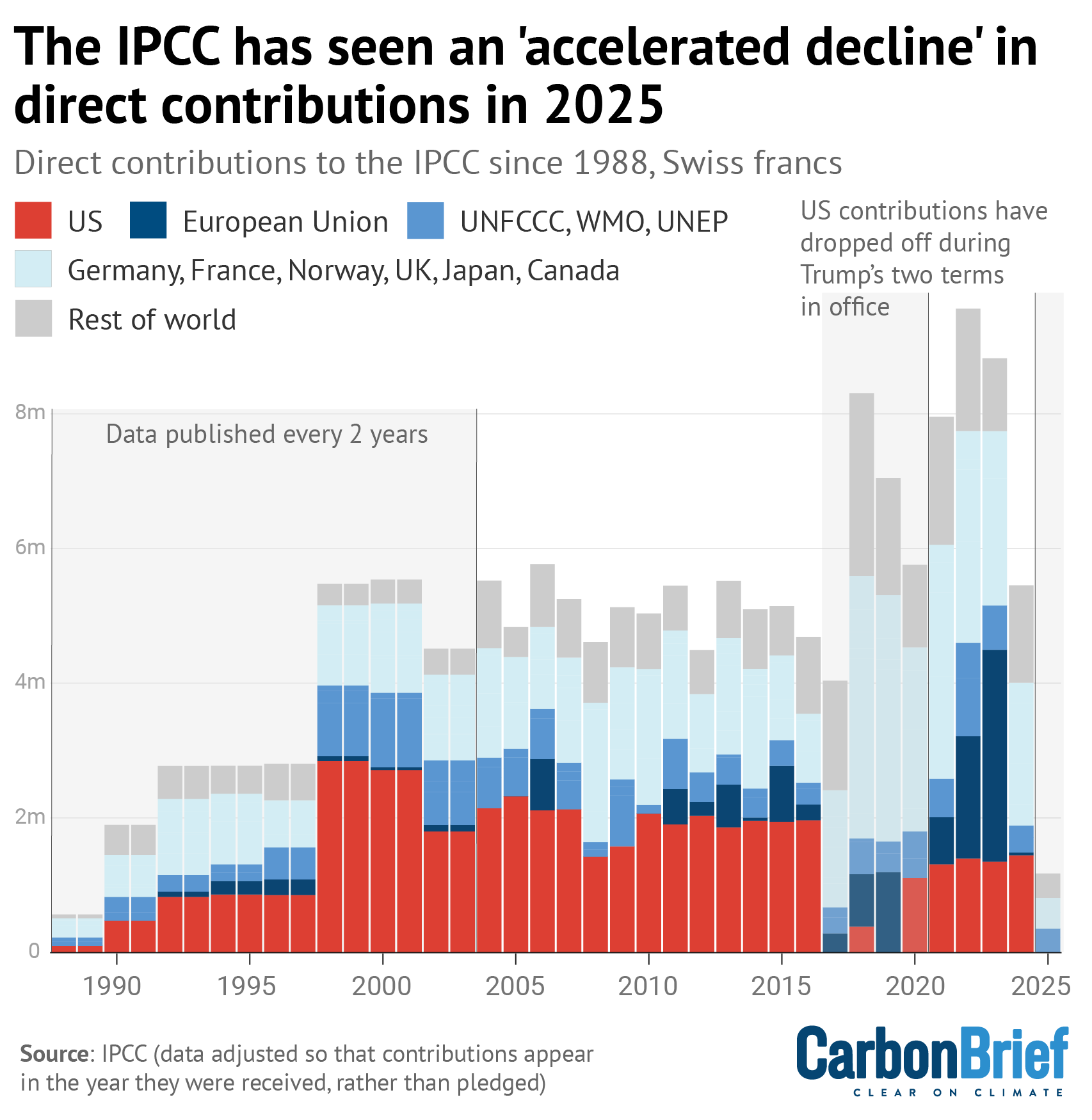
Chart showing the largest direct contributors to the IPCC since its inception in 1988, with the US (red bars), European Union (dark blue) and UNFCCC/WMO/UNEP (mid blue) highlighted. Grey bars show all other contributors combined. Figures for 2025 are January to June inclusive. Figures for 1988-2003 are reported per two years, so these totals have been divided equally between each year. Source: IPCC (2025) and (2010). Contributions have been adjusted, as per IPCC footnotes, so they appear in the year they are received, rather than pledged.
The largest direct contributions to the IPCC trust fund so far this year have come from Norway (244,000 Swiss francs, or £230,000), the UNFCCC (230,000 Swiss francs, or £220,000), Canada (210,000 Swiss francs, or £200,000) and the WMO (125,000 Swiss francs, or £118,000).
Other countries to contribute this year include Australia, New Zealand, Pakistan, Peru, South Korea, Sweden, Trinidad and Tobago, and 213 Swiss francs (£200) from Cambodia.
The US – which has provided 30% of the IPCC’s direct contributions throughout its history – has not made a contribution so far this year.
In its final decision, the panel invited “member countries to make their annual voluntary contributions to the IPCC trust fund and, if possible, to increase [them]”, says the ENB.
Member countries also discussed a proposal from the WMO for the IPCC to pay 300,000 Swiss francs (£280,000) for administrative support that was previously provided as an in-kind contribution.
Given the “deteriorating financial situation” of the IPCC, the ENB reports that a decision on this proposal was deferred – not to the next meeting, but the one after that.
Progress reports and next steps
The Lima meeting was also an opportunity for each IPCC working group to update the rest of the delegates on progress since the last meeting.
All working groups discussed the process of selecting authors for the IPCC’s upcoming seventh assessment, highlighting their efforts to be “inclusive”.
For example, the WG3 co-chair said 52% of the selected WG3 authors are from developing countries, 40% are female and 59% are new to the IPCC.
A WG2 co-chair also reported that six chapter scientists had been selected from more than 1,320 applications for the special report on cities slated for publication in March 2027.
In addition, the WG1 co-chairs outlined their preparations for the first joint-lead author meeting for their assessment report, which will be held in December 2025.
They also laid out plans for a cross-working group “expert meeting” on “Earth system high impact events, tipping points and their consequences”, co-sponsored by the World Climate Research Programme (WCPR).
The meeting also granted “observer status” to 20 new organisations, allowing them to attend IPCC sessions and nominate experts as authors or workshop leads.
The IPCC confirmed that its next meeting will be held in Bangkok, Thailand over 24-27 March 2026.
Skea announced that workshops on “diverse knowledge systems and methods of assessment” will be held in February 2026 at the University of Reading in the UK.
Skea also proposed an expert meeting to “support the transition from conceptual design to technical implementation” of the AR7 WG1 and WG2 interactive atlases.
The atlases are interactive online tools that allow users to explore much of the data underpinning the working group reports.
The meeting was approved, subject to agreement on the budget. It is slated to take place between April and June 2026.
The post Ongoing failure to agree AR7 timeline is ‘unprecedented’ in IPCC history appeared first on Carbon Brief.
Ongoing failure to agree AR7 timeline is ‘unprecedented’ in IPCC history
Greenhouse Gases
COP30: What does the ‘Baku to Belém roadmap’ mean for climate finance?
The Brazilian COP30 presidency has published a “Baku to Belém roadmap” on how climate finance could be scaled up to “at least $1.3tn” a year by 2035.
The idea for the roadmap was a late addition to the outcome of COP29 last year, following disappointment over the formal $300bn-per-year climate-finance goal agreed in Baku.
The new document, published ahead of the UN climate talks in Belém, Brazil, says it is not designed to create new financing schemes or mechanisms.
Instead, the roadmap says it provides a “coherent reference framework on existing initiatives, concepts and leverage points to facilitate all actors coming together to scale up climate finance in the short to medium term”.
It details suggested actions across grants, concessional finance, private finance, climate portfolios, capital flows and more, designed to drive up climate finance over the next decade.
Despite geopolitical uncertainty, there is hope that this roadmap can lay out a pathway to the “trillions” in climate finance that developing countries say they need to meet their climate targets.
Countries have divergent views on how to get there, but some notable trends have emerged from the roadmap, which was spearheaded by the Azerbaijani and Brazilian COP presidencies.
Below, Carbon Brief details what the Baku to Belém roadmap is, why it was launched and what the key points within it are.
- Why was the ‘Baku to Belém roadmap’ launched?
- What is the goal of the roadmap?
- What are different countries’ views on climate finance?
- What are the solutions that the roadmap has identified?
- What happens next?
Why was the ‘Baku to Belém roadmap’ launched?
A mounting body of evidence shows that developing countries will need trillions of dollars in the coming years if they are to achieve their climate goals.
While much of this finance will likely be sourced domestically within those countries, a large slice is expected to come from international actors.
This climate finance is part of the “grand bargain” at the heart of the Paris Agreement, whereby developing countries agree to set more ambitious climate plans if they receive financial support from developed countries.
Ahead of COP29, developing countries hoped that the post-2025 climate finance target – known as the new collective quantified goal (NCQG) – would reflect their full “needs and priorities”, as set out in the Paris Agreement.
They also pushed for developed-country parties such as the EU, the US and Japan to contribute a large portion of this finance, preferably on favourable terms such as grants.
They were left largely disappointed, with a final target that fell well short of what many developing countries had been proposing.
The central target agreed at COP29 was “at least” $300bn a year by 2035, with an expectation that developed countries would “take the lead” in providing these funds from “a wide variety of sources”, including private finance.
This goal – which was effectively the successor to the previous $100bn-per-year target – was far short of what developing countries had wanted. However, another key part of the text agreed in Baku alludes to their ambitions, with a loose request that “all actors” scale up finance to at least $1.3tn per year by 2035:
“[The COP] calls on all actors to work together to enable the scaling up of financing to developing country parties for climate action from all public and private sources to at least $1.3tn per year by 2035.”
In contrast to the $300bn target, this $1.3tn figure, which first appeared in a proposal by the African Group in 2021, reflects developing-country demands and needs. It also aligns with influential analysis of developing-country needs by the Independent High-Level Expert Group on Climate Finance (IHLEG).
Yet, this part of the text lacked binding language and detail on who precisely would be responsible for providing these funds. It has therefore been described by civil-society groups as more of an aspirational “call to action” than a target.
(“Calls on” is the weakest form of words in which UN legal texts can make a request.)
However, the COP29 text contained another relevant decision, added as negotiations drew to a close. It mentioned a “Baku to Belém roadmap to $1.3tn” – a report that could flesh out ways to scale up finance further and help developing countries achieve their climate targets.
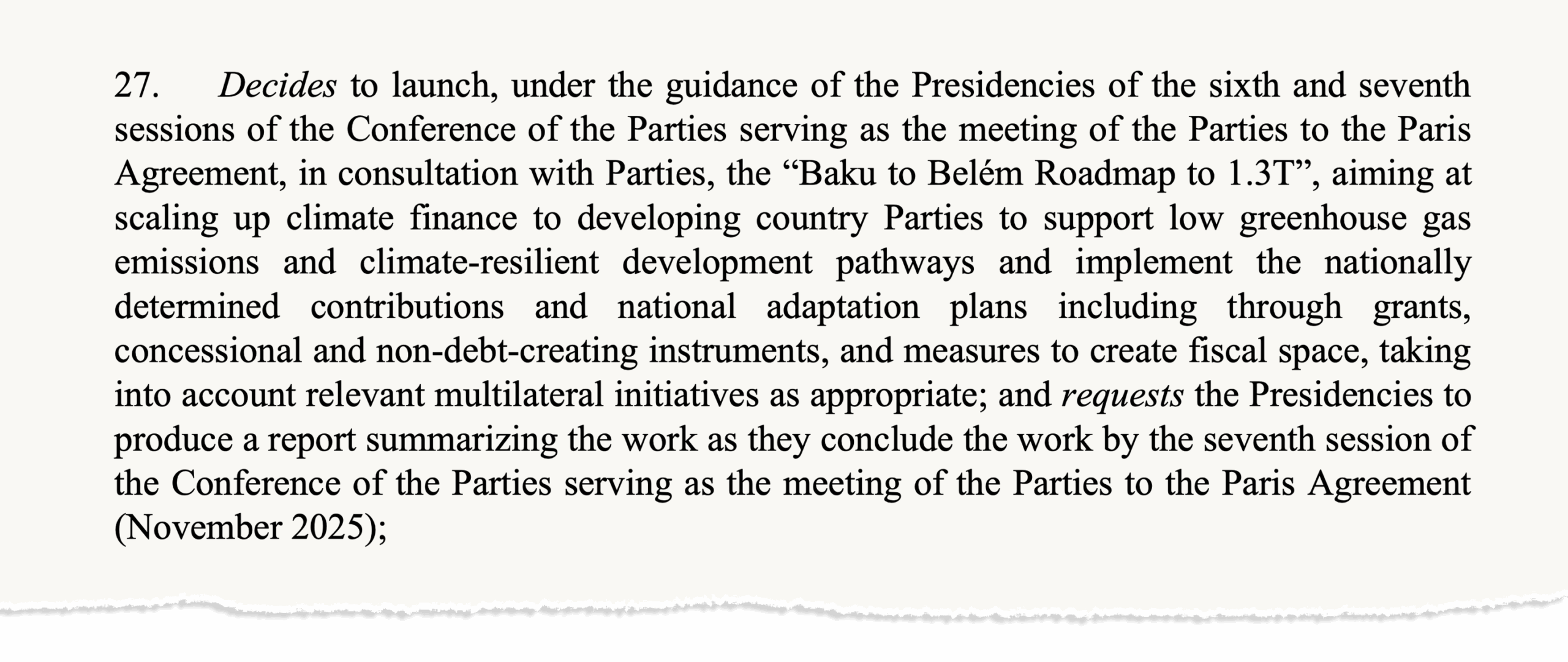
The Azerbaijani COP29 presidency and the incoming Brazilian presidency were tasked with assembling this roadmap ahead of COP30 in 2025.
In the months that followed, the presidencies engaged with governments, civil-society groups, businesses and other relevant actors. They gathered information to build a “library of knowledge and best practices”, which could boost climate finance for developing countries.
What is the goal of the roadmap?
The roadmap comes at a difficult time for climate finance, with a particularly “bleak” outlook for public funding from developed countries. Major donors – particularly the US – have made large cuts to their aid budgets, threatening climate spending overseas.
At the same time, private investment has also faltered, with successive economic shocks raising the cost of capital for clean-energy projects in developing countries.
For years, finance experts and development leaders have talked of a “billions to trillions” agenda, suggesting that public money could help to “mobilise” trillions of dollars of private investments that could be used to build low-carbon infrastructure in the global south.
Yet, the “billions to trillions” concept has also faced growing scrutiny, with even the World Bank chief economist Indermit Gill branding it “a fantasy”. Critics have highlighted wider issues constraining developing countries, such as high levels of debt.
The NCQG text from COP29 set out the roadmap’s overarching goal of scaling up annual climate finance to $1.3tn, through means including “grants, concessional and non-debt-creating instruments, and measures to create fiscal space”.
On the current trajectory, financial sources potentially covered by the target could hit around $427bn for developing countries a year by 2035, less than a third of the goal, according to analysis by the thinktank NRDC.
Achieving $1.3tn of finance relies on what one report calls “yet-to-be-defined mechanisms”, which go beyond the ones covered by the $300bn target.
Countries and other relevant parties were asked by the presidencies for their views on “short-term” – actions by 2028 and “medium-to-long term” actions beyond 2028 that could ramp up finance further. They were asked about new sources of finance and thoughts on scaling up adaptation finance, in particular.
There have already been numerous ideas and programmes put forward for scaling up international climate finance. These include G20-led reforms of the multilateral development banks (MDBs), this year’s International Conference on Financing for Development, as well as UN sovereign debt restructuring efforts.
Accordingly, the Baku to Belém roadmap was also given a remit to “tak[e] into account relevant multilateral initiatives as appropriate”. Parties were also asked for suggestions of organisations and initiatives that should be involved.
Rebecca Thissen from Climate Action Network (CAN) International tells Carbon Brief:
“The roadmap could support the UNFCCC to be sending strong signals to the international community…But also using the convening power that the UNFCCC could have, so bringing those different actors to the table in a more structured and predictable way.”
What are different countries’ views on climate finance?
There were over 227 submissions into the Baku to Belém roadmap, including 38 from countries and party groupings. The remainder came mainly from NGOs, businesses, financial experts and researchers, as shown in the figure below.

The submissions partly reflect what the thinktank C2ES describes as the “pockmarked baggage of the climate finance negotiations”, with many parties demonstrating the same entrenched, often opposing views on climate finance that they have held for decades.
Carbon Brief has captured the submissions by countries and party groupings in the interactive table below, comparing their views on key issues.
There is broad agreement among countries that the roadmap should not reopen the NCQG discussions or involve a new, negotiated outcome at COP30.
However, some parties still call for more accountability in achieving the existing goals.
Latin American countries within the AILAC grouping call for the roadmap to “define concrete milestones for scaling up climate finance”. Egypt goes further, proposing that developed countries alone commit “at least $150bn annually in public concessional finance by 2028”, mainly as grants.
A key divergence in submissions is on which governments and institutions, precisely, should be responsible for scaling finance up to $1.3tn.
Several developing-country groups stress the importance of centring developed countries as the primary contributors, referencing Article 9.1 of the Paris Agreement.
The Like-Minded Developing Countries (LMDCs) group, which includes India, China and Saudi Arabia, states that “the roadmap must place Article 9.1 as its central pillar”. The G77 and China – a group representing all developing countries – stresses the “additional role developed countries will play in the context of Article 9.1, which is additional to the $300bn”.
Meanwhile, many developed countries focus on what Canada refers to as “a necessary broadening of climate finance” within the roadmap. In practice, this often amounts to a greater push for private finance, as well as “innovative” new sources such as global levies.
While developing countries do not often outright oppose such sources, some of them propose tighter limits. For example, China says “purely commercial investment flows should not be included” in the $1.3tn, which should only count funds “mobilised through public interventions”.
A related dispute centres on the roadmap’s scope, with the EU suggesting it should “extend beyond the UNFCCC framework”.
Parties such as India reject the idea of involving other multilateral fora, such as the G20. This would involve moving beyond the UN climate process, where developed countries have traditionally been the ones responsible for channelling climate finance.
The submissions also show notable differences among developing-country groupings. On the topic of defining what should be counted as “climate finance”, the Alliance of Small Island States (AOSIS) opposes the inclusion of funding for fossil-fuel projects, while the Arab Group says it does not support “any exclusionary criteria”.
There is coalescence between parties around other issues, albeit with various subtle differences.
Areas of broad agreement include the importance of more funding for climate adaptation, dealing with “barriers” to funding in developing countries and improving the transparency of climate-finance provision.
The roadmap details some of the potential sources of finance identified within the submissions.
This includes direct budget contributions, which the submissions suggest could generate an additional $197bn in financing; improved rechanneling and new issuances of special drawing rights ($100-500bn per year); carbon pricing ($20-4,900bn, dependent on rate and geographies); and fees on aviation or maritime transport($4-223bn).
Additionally, a range of taxes were identified as candidates for raising new climate finance. These include taxes on specific goods such as luxury fashion, technology and military goods ($34-112bn), financial transactions taxes ($105-327bn), minimum corporate taxes ($165-540bn) and wealth taxes ($200-1,364bn).
In a statement, Rebecca Newsom, global political expert at Greenpeace International, said:
“It’s notable that the roadmap recognises new taxes and levies as key to unlocking public climate finance. Given reported profits from just five international oil and gas giants over the last decade reached almost $800bn, taxing fossil fuel corporations is clearly a huge opportunity to overcome national fiscal constraints.
“The roadmap’s recognition that the UN tax convention provides an opportunity to raise new sources of concessional climate finance is also highly welcome, and is an opportunity governments must now seize.”
What are the solutions that the roadmap has identified?
The roadmap sets out “five action fronts” for reaching $1.3tn by 2035.
These are designed to “help deliver on the at-least-$1.3tn aspiration by strengthening supply, making demand more strategic, and accelerating access and transparency”.
The report titles these five action fronts as “replenishing, rebalancing, rechanneling, revamping and reshaping”.
Within each of these, the roadmap lays out key points to help “transform scientific warning into a global blueprint for cooperation and tangible results”.
The first, “replenishing”, refers to grants, concessional finance and low-cost capital, including multilateral climate funds and MDBs.
It notes that there is a “growing role” for MDBs in advancing climate action, as well as a need for developed countries to achieve “manyfold increases in the delivery of grants and concessional climate finance, including through bilateral and multilateral channels”.
Access to grants and concessional finance is a key enabling factor for an “efficient” flow of public funding, the roadmap notes.
The roadmap calls for coordination in the international finance system, bilateral finance that is concessional and low-cost, multilateral climate funds, innovative sources of concessional finance with simplified access pathways and more.
This coordination could be key, with Sarah Colenbrander, director of ODI’s climate and sustainability programme, telling Carbon Brief:
“The bigger risk is probably that some countries will allocate their climate finance differently, so that they can report more money going out the door without a commensurate increase in fiscal effort. For example, they might shift from grants to concessional loans, and from concessional loans to market-rate loans. If the money will be repaid, there is less lift for taxpayers at home.
“Alternatively, countries might focus on using public finance to mobilise private finance that can also count towards the $300bn goal. Private finance has a very important role to play in both mitigation and adaptation, but it is very unlikely to meet the needs of the most vulnerable communities, given their high adaptation investment needs and very limited ability to pay.”
In particular, the roadmap suggests MDBs “intensify their engagement on climate finance through a strategic approach that recognises and amplifies their catalytic role in providing and mobilising capital”.
Second, “rebalancing” refers to fiscal space and debt sustainability. The roadmap calls on creditor countries, the International Monetary Fund (IMF) and MDBs to work together to “alleviate onerous debt burdens faced by developing countries”.
The roadmap notes that external debt servicing costs of developing countries have more than doubled since 2014, to $1.7tn per year in 2023.
Developing countries’ net interest payments on public debt reached $921bn in 2024, a 10% increase compared to 2023, it adds.
The roadmap notes the need to “remove barriers and address disenablers faced by developing countries in financing climate action”. It adds that developing countries face at least two- to four-times the borrowing costs of developed countries.
It points to a number of “promising” solutions already being implemented, such as climate-resilient debt clauses and “debt-for-climate swaps” and debt restructuring.
In particular, MDBs, the IMF, UN agencies and regional UN economic commissions could work together to create a “one-stop shop” for assistance in these areas, the roadmap says.
Third, “rechannelling” refers to “transformative” private finance and affordable cost of capital.
It notes that mobilisation of private finance has been “stubborn to scale”: The level of private finance leveraged by official development interventions has grown by 7% per year from 2016 to 2019 and then 16% per year from 2020 to 2023, to reach $46bn.
The roadmap says that “blended finance” can play a role in scaling up climate finance and that private finance for the implementation of “nationally determined contributions” to cutting global emissions (NDCs) and national adaptation plans (NAPs) has “significant potential for growth”.
“Innovative instruments” are listed as a key approach to improving private finance, including “catalytic equity”, guarantees, foreign exchange risk management, securitisation platforms and more.
To support this, the roadmap calls for target-setting and data transparency, along with increasing, coordinating and harmonising guarantee offerings and channelling concessional finance into long-term foreign exchange hedging facilities, along with other actions.
Relying heavily on private finance could pose a risk, Jan Kowalzig, senior policy adviser for climate at Oxfam Germany, tells Carbon Brief, adding:
“The much larger problem, however, is the plan to massively rely on private finance in the future. While private finance has a key role to play to transform economies, [it] cannot replace much-needed public finance, especially for adaptation and for responding to loss and damage.
“Interventions in these sectors often do not generate return to satisfy investors’ expectations. Forcing projects to become profitable can come at great social cost for frontline communities struggling to survive in the worsening climate crisis.”
The roadmap suggests financial institutions move towards “originate-to-distribute” and “originate-to-share” business models, support the development of climate-aligned domestic financial systems and expand investor bases and diverse sources of capital, amongst other proposals.
Fourth is “revamping”, referring to capacity and coordination for scaled climate portfolios. This “demands institutions to manage risks locally, develop project pipelines, ensure country ownership and track progress and impact”.
It notes that “whole-of-government” approaches to the transition can be strengthened, with NDCs and NAPs integrated throughout national investment strategies. Additionally, it points to country-led coordination or platforms as a route for improving investment.
The roadmap suggests readiness support and project preparation as routes to “revamp” climate finance, alongside support to scale, coordinate and tailor capacity building, the development of country platforms and the provision of “predictable and flexible support for investment frameworks”.
The final “R” is “reshaping”, focused on systems and structures for capital flows. It highlights a number of barriers that still remain for capital flows through developing countries, including outdated clauses in investment treaties.
It recommends prudential regulation, interoperability of taxonomies, climate disclosure frameworks and investment treaties, as key actions to support the reshaping of capital flows.
Additionally, the roadmap suggests that credit rating agencies further refine their methodologies, that jurisdictions adopt voluntary disclosure of climate-related financial risks of financial institutions and that climate stress-test requirements are gradually embedded in supervisory reviews and bank risk management.
Beyond the “five [finance] action fronts”, the roadmap sets out five thematic areas, noting that “where and how finance is directed” matters.
These are: adaptation and loss and damage; clean-energy access and transitions; nature and supporting its guardians; agriculture and food systems; and just transitions.
Within each, it sets out some of the key challenges and suggests routes for financial support.
What happens next?
The Baku to Belem roadmap is not a formal part of COP30 negotiations, but there will be a major launch event at the summit.
Beyond that, the final section of the roadmap sets out that this is the “beginning [of] the journey”. It and details suggested short-term contributions (2026-2028), to serve as “initial, practical steps to inform and guide the early implementation of the roadmap”.
This includes the Azerbaijani and Brazilian presidencies convening an expert group tasked with refining data and developing “concrete financing pathways” to get to $1.3bn in 2035. This will build on the action fronts set out in the roadmap, with the first such report due by October 2026.
Throughout 2026, the presidencies will convene dialogue sessions with parties and stakeholders to discuss how to progress the action fronts over the medium to long term.
The roadmap suggests that to improve predictability, developed countries “could consider” working together on a delivery plan to outline how they expect to achieve the at-least $300bn goal by 2030, as well as other elements of the NCQG.
Additional suggestions in the roadmap are listed in the table below.
(Notably, almost all of these suggestions are made using loose, voluntary language. For example, the roadmap says that developed countries “could” create a delivery plan for their NCQG pathways.)
| Who | What | When |
|---|---|---|
| COP29 and COP30 presidencies | Convene an expert group to develop “concrete financing pathways” | October 2026 |
| COP29 and COP30 presidencies | Convene dialogue sessions with parties and stakeholders | 2026 |
| Developed countries | Creating a delivery plan to set out intended contributions and pathways for NCQG targets | End of 2026 |
| Parties to the Paris Agreement | Request the Standing Committee on Finance to provide an aggregate view on pathways for NCQG | 2027 |
| Governments | Request UN entities to examine and review collaboration options | October 2026 |
| Multilateral climate funds | Report annually on the implementation of their “operational framework” on complementarity and coherence, to enhance cross-fund collaboration. | Annually |
| Multilateral climate funds | Develop monitoring and reporting frameworks and coordination plans, explaining their operations by region, topic and sector | October 2027 |
| Multilateral development banks | Collective report on achieving a new aspirational climate finance target for 2035 | October 2027 |
| Multilateral development banks | Adopt “explicit, ambitious and transparent targets for adaptation and private capital mobilisation” | October 2027 |
| International Monetary Fund | Conduct an assessment of the costs, benefits and feasibility of a new issuance of “special drawing rights” | October 2027 |
| UN regional economic commissions | Develop a study on the potential for expanding debt-for-climate, debt-for-nature and sustainability-linked finance | End of 2027 |
| UNSG-convened working group | Propose a consolidated set of voluntary principles on responsible sovereign borrowing and lending. | October 2026 |
| Crediting rating agencies | Develop a structured dialogue platform with ministries of finance to make progress on refinements to credit rating methodologies. | October 2027 |
| Philanthropies | Expand funding of knowledge hubs | October 2026 |
| UN treaty executive secretariats | Develop a joint report with proposals on economic instruments to support co-benefits and efficiencies | End of 2027 |
| Insurance Development Forum and the V20 | Establish a plan for achieving cheaper and more robust insurance and pre-arranged finance mechanisms for climate disasters | October 2026 |
| Financial Stability Board, the Basel Committee on Banking Supervision and the International Association of Insurance Supervisors | Conduct a joint assessment of whether and how barriers to investment in developing countries could be reduced | October 2027 |
| World’s 100 largest companies | Report annually on how they are contributing towards the implementation of NDCs and NAPs | Annually |
| World’s 100 largest institutional investors | Report annually on how they are contributing towards the implementation of NDCs and NAPs | Annually |
COP29 president Mukhtar Babayev and COP30 president André Aranha Corrêa do Lago conclude in the foreword of the report that while the $1.3bn “journey” is beginning amid “turbulent times”, they are confident that “technological and financial solutions exist”. They add:
“Communities and cities are acting. Families and workers are ready to roll up their sleeves and deliver more action. If resources are strategically redirected and deployed effectively – and if the international financial architecture is reset to fulfil its original purpose of ensuring decent prospects for life – the $1.3tn goal will be an achievable global investment in our present and our future. We are optimistic.”
The post COP30: What does the ‘Baku to Belém roadmap’ mean for climate finance? appeared first on Carbon Brief.
COP30: What does the ‘Baku to Belém roadmap’ mean for climate finance?
-
Climate Change3 months ago
Guest post: Why China is still building new coal – and when it might stop
-
Climate Change2 years ago
Spanish-language misinformation on renewable energy spreads online, report shows
-
Greenhouse Gases3 months ago
Guest post: Why China is still building new coal – and when it might stop
-
Climate Change Videos2 years ago
The toxic gas flares fuelling Nigeria’s climate change – BBC News
-

 Greenhouse Gases1 year ago
Greenhouse Gases1 year ago嘉宾来稿:满足中国增长的用电需求 光伏加储能“比新建煤电更实惠”
-

 Climate Change1 year ago
Climate Change1 year ago嘉宾来稿:满足中国增长的用电需求 光伏加储能“比新建煤电更实惠”
-

 Carbon Footprint2 years ago
Carbon Footprint2 years agoUS SEC’s Climate Disclosure Rules Spur Renewed Interest in Carbon Credits
-
Renewable Energy4 months ago
US Grid Strain, Possible Allete Sale



